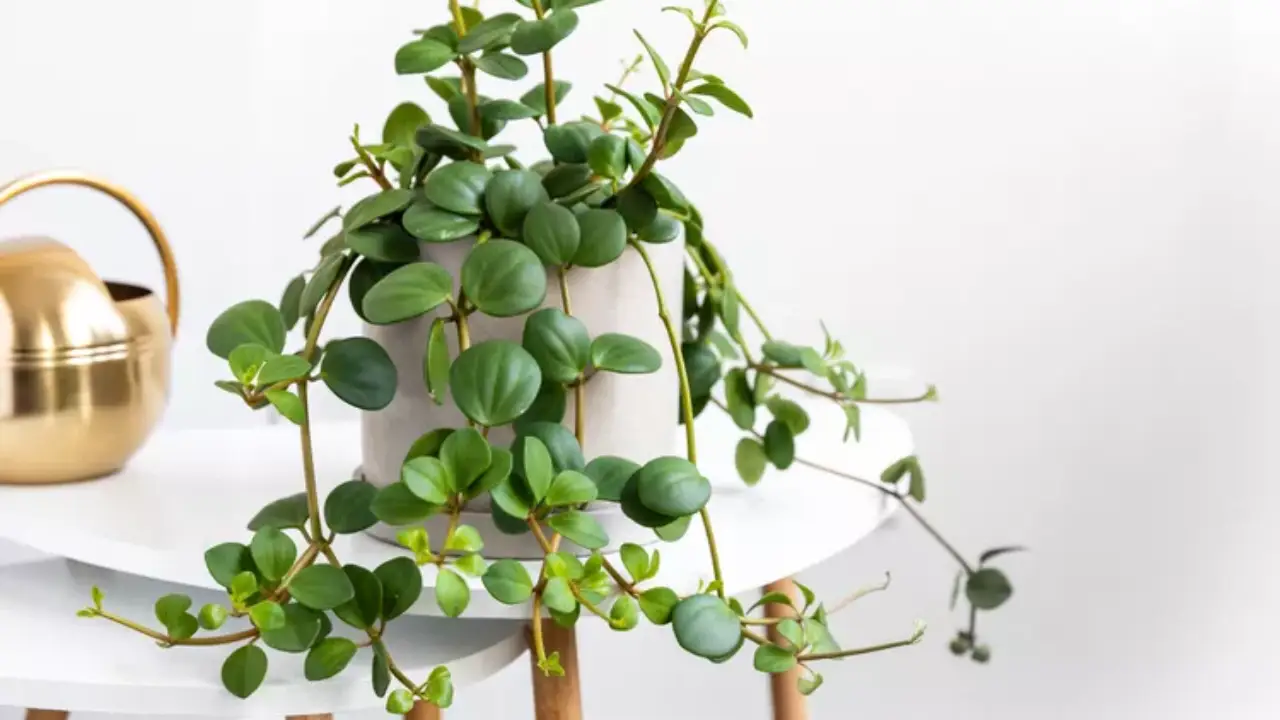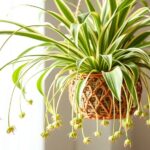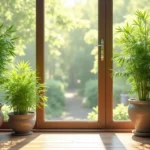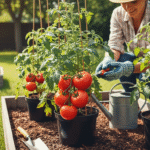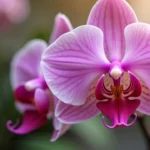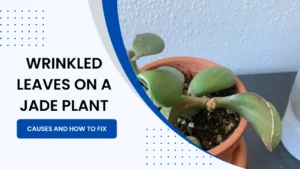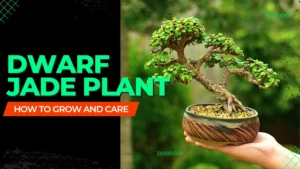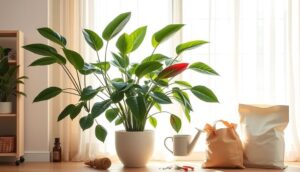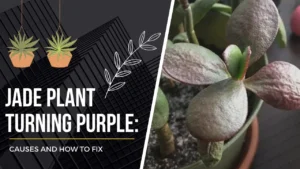Are you also amazed by the trailing jade plant? Who isn’t? This easy-to-maintain hanging jade plant elevates the look of your living space. You came to the right place if you want to grow these beauties in your home.
Before we hop on how to care for a trailing jade plant, let’s learn a little more about the plant.
Table of Contents
Trailing Jade Plant
It has attractive long, soft stems covered with many tiny, spherical leaves. The leaves beautifully intertwine and weave in and out of one another. Like other Peperomias, the leaves are almost rounded, thick, and juicy. You can also see that the deeper green leaves have lighter veins.
Quick Facts About Hanging Jade Plant
- It can blossom into tiny, white blooms. However, these flowers can be seen blooming on spikes. Some people find them to be unattractive or dull.
- The primary usage of the trailing jade plant is for its distinctive foliage.
- This plant is a type of vine.
- Its stems tend to develop in a creeping or trailing manner.
- It is a succulent plant native to Tanzania and Kenya.
- It is called trailing jade (Kleinia Petraea or Senecio jacobsenii).
- It is also known as vining jade or weeping jade.
- Trailing jade is not closely related to Crassula jade (Crassula ovata), even though it resembles it and is likewise a succulent.
- Plants that trail jade is simple to establish and develop quickly. They have trailing growth patterns, making them suitable for ground coverings or hanging pots.
How to Grow the Trailing Jade Plant?
If you bought your hanging jade plant from a nursery or at an online store, you could easily plant it.
- Choose a pot or container with one or two drainage holes at the bottom.
- Fill the medium with soil.
- Plant the trailing jade in the pot.
- Water your trailing jade plant thoroughly and place it in a sunny location.
How to Propagate Trailing Jade
Similar to many other succulent plants, trailing jade propagation is not too difficult.
1) Cut a few cuttings.
You can take either a stem or a leaf from an existing trailing jade plant as both are known to root. A stem cutting will expand more quickly than a leaf cutting.
2) Allow your cuttings to dry.
Let the cuttings dry out on a clean towel in a dry area for a few days. It stops root rot.
3) Place the cutting in the soil.
You can use sandy soil and lots of perlites. It will aid in drainage when planting or replanting your trailing jade. The hanging jade plant is a succulent that is extremely sensitive to overwatering.
4) Before watering, let your new trailing jade plant root.
You should look for signs of roots. You can notice white strings emerging from the base of the cutting. Let it root before watering your new plant. You can water the roots that emerge.
Now when you know how to grow your trailing jade plant, the question pops up, where to grow them? Indoors or outdoors? What surroundings to create for them to grow?
Where to Grow the Hanging Jade Plant?
Outdoors
As a succulent, trailing jade retains water in its thick leaves and stems. Because of this, it can endure times of drought. But the plant needs some water to stay in top condition.
You should water your trailing jade plant occasionally if you plant it outdoors during the summer. Yet, make sure the soil is never wet for an extended period. Sandy and incredibly well-draining soil are ideal.
The succulent will require even less water in the winter because it will be dormant. Only water the soil when it is extremely dry.
The trailing jade prefers full sun or moderate shade like many succulents do. It should be no surprise that the plant, native to tropical Africa, enjoys hot weather. It doesn’t do well in extreme shadow or cold environments.
However, trailing jade is a low-maintenance ground cover when grown outside in well-draining soil. The trailing jade plant can efficiently stabilize slopes in this way.
Indoors
When growing the hanging jade plant as an indoor plant, you should consider the soil, drainage, and location. Indoor container plants need excellent drainage. Unlike outdoor trailing jade, sitting in wet soil will kill them.
You should plant it in a particular succulent/cactus potting soil or, failing that, a very well-draining soil. Make sure your pot or hanging basket you are using has enough drainage holes.
Place the indoor plant where your trailing jade will receive some direct sunlight. If your afternoons are hot, choose a window that receives early sunlight instead. The trailing jade plant needs sunlight but could scorch if it’s too hot inside.
The hanging jade plant doesn’t require fertilizer, like most succulents. It will occasionally need water, though. While watering the plant, give it enough, so the soil in its container is entirely saturated. Then wait until the soil is arid before watering it again.
Now we will guide you on caring instructions for the trailing jade plant. Although these are basic tips, follow them to make your plant happy.
How to Care for a Trailing Jade Plant?
1) Sunlight
You need to provide a hanging jade plant with tons of sunlight for the best appearance. It would be beneficial to locate the plants there so they may receive at least 5 to 6 hours of sunlight each day.
However, too much sunlight causes the plants’ appearance to decline due to solar damage. They thrive in rich outdoor splendor in spring and summer. Although, hanging jade plant care includes keeping it close to the window if cultivated indoors. In this way, they can get plenty of sunlight all day long.
Keep these plants in the room with the most light if your home doesn’t have bright sunlight. Less light causes plants to develop slowly and produce less attractive leaves.
You should keep the trailing jade plant indoors throughout the winter to prevent frost. But, it is helpful to have winter sun where you live. It is crucial to keep the plants indoors once the sun has set.
2) Water
It would be sufficient to water the trailing jade plant once or twice every two to three weeks for them to grow but check it frequently. Hanging jade plant care includes watering sparingly, especially in colder climates. It prevents simple root decay.
It is not suitable for trailing jade to have too much water. Daily watering could result in rotting roots, which could destroy them. Signs of overwatering are soft, yellowing, or falling leaves.
When to water the hanging jade plant?
Check the soil by sticking your fingers one inch into it to determine when it is ideal to water. The plants need water when the soil seems dry, and your finger comes out clean.
For up to 15 days, the trailing jade plant can survive without water. Underwatering them, though, can cause leaf fallouts. However, hanging jade plant care includes keeping them inside during the winter. It is pretty okay to water them less.
3) Soil
Trailing jade plant care includes planting in quick-draining soil. We advise you not to use ordinary soil as it can keep too much moisture.
You should combine the soil with twigs, pumice, or sand. This mixture will aid in quick water drainage. You can use different soil combinations created specifically for hanging jade plant care.
Yet, you can create the soil mixture using a mild mixture of coarse sand, potting soil, and pumice. With a less dense hold on the water, this soil allows for aeration in the potting mix. Like other succulents, these plants thrive in loose, sandy potting soil. So it’s essential to incorporate sand into your usual soil mix.
4) Temperature
To maintain an ideal temperature, you should keep your trailing jade plant outdoors in the summer, facing northeast. In this way, the plants will get moderately abundant sunlight.
Hanging jade plant care includes keeping them at temperatures between 18 and 21. Therefore, even if you keep them inside, place them next to a window facing the sun. Avoid leaving them outside during the winter when it is below freezing. They can, however, withstand temperatures as low as 10 degrees Celsius.
You can look at your plants’ blackening steam and decaying appearance to determine whether cold temperatures have harmed them. Trailing jade plant care includes keeping them indoors and in a well-lit space during winter.
5) Humidity
You should mist the leaves in the summer season. Grouping the plant with other plants is a good idea because it does prefer high humidity. Most plants will be alright with average indoor humidity levels. But if dry air problems arise, take measures to improve the humidity.
6) Fertilizer
The Trailing Jade plant will enjoy fertilizer feeding much like other plants. However, hanging jade plant care includes caution when selecting the proper fertilizer. The plant benefits from a fertilizer with a nitrogen, phosphorus, and potassium ratio of 10:20:10.
Organic fertilizers are typically the best choice. Trailing Jades prefer to hibernate during the colder months. The optimum time to fertilize them is during the growing season.
You should give them enough food to plant once every spring or summer. But, you can omit the fertilizer if you prefer a short, bushy plant.
7) Repotting
The trailing jade plant can grow in the same container for many years without repotting. So, keeping these plants a little root-bound rather than placing them in a big container is best.
On the other hand, hanging jade plant care includes changing the soil or topsoil once a year. When these plants appear very bushy, we should repot them. Another situation where repotting is necessary is when the roots begin to emerge from the drainage holes. Or when the pot seems to be about to blow up.
How to repot?
- Repotting is an easy process of removing extra soil from the roots and moving the plant from the pot.
- Put the plant back into a larger, empty pot after removing any dead roots you may have noticed.
- Add loose soil after that until the roots are entirely covered. Finally, add organic fertilizer to the container.
Note for Hanging Jade plant care:
- As they are hardy, trailing jade plants will thrive in new pots without withering. Yet, for the plants to succeed, they require appropriate nutrients, water, and a warm atmosphere.
- You can repot your trailing jade plant in the spring. Repotting should be avoided throughout the winter, as the jade plant goes dormant during the colder months.
- Additionally, summers are not the ideal season to repot. Therefore, avoid repotting the jade plant in the summer when it is growing.
8) Pruning
If the right circumstances are present, the trailing jade plant only needs modest pruning. However, it is preferable to perform occasional trimming to promote bushier plant growth. The Jade plant will remain compact and healthy.
- To prune the plant, you can pinch the undesirable stem tips with your fingers or a pair of tiny scissors.
- Leggy stems frequently provide visual disturbances. The Trailing Jade plants grow quickly. Therefore, hanging jade plant care includes pruning them in the spring and at the start of the summer.
- You can prune after the blooming period before the plant enters dormancy if you forget to prune in the spring or summer.
9) Common Pests and Diseases
1) Brown Tips: When there is a sharp temperature fluctuation, brown tips can appear. You can witness the same when your trailing jade plant is near a draughty window or radiator in winter. Remove the leaves with brown tips if you also change the environmental factors.
2) Wilting leaves: Succulents that dry out too much between waterings have leaves that crisp up and fall off. Until you see new growth, pinch out the sad-looking growth. Hanging jade plant care includes keeping the soil uniformly moist. Put the plant in a plastic bag or other sealed space.
3) Yellow foliage: Too much water is probably the cause of your plant’s yellowing leaves. It can cause mold to grow on the top layer of soil and withering stems. Even though it may be a common cause of death, there is still hope.
4) Loss of leaves suddenly: This can state your trailing jade plant is shivering. You can keep it at a minimum 10 degrees temperature.
If you keep caring for your hanging jade plant, it will be healthy and won’t get any diseases. However, keep an eye on mealybugs who might get attracted to dim lighting.
Conclusion
The hanging jade plant is an ideal plant for new plant parents or someone who forgets to care for them. These plants look best on the shelves, floor, or in hanging baskets.
These have an appealing aura and elevate the look of the space. The round-shaped leaves capture the attention quickly. It makes a beautiful addition.
Follow the care instructions to grow the trailing jades, and you will have a great green companion beside you. If you have any queries about how to care for a trailing jade plant, mention them in the comments.
Frequently Asked Questions
Q1. Are pets safe around the trailing jade plant?
Pets and trailing jade plants can get along just well because it is not poisonous to animals.
Q2. What is the growth rate of the hanging jade plant?
There’s no need to be concerned about it violating your territory. It doesn’t get much bigger than the length of a typical ruler and grows slowly. It may add only two inches to a happy specimen each year.
Q3. Can beginners grow a trailing jade plant?
Like other species of jade plants, trailing jade plants are excellent for amateur gardeners. These plants are perfect for people who prefer minimum maintenance and have limited floor space.
1. You do not need to water these gorgeous-looking plants frequently. They have their water storage in their thick, green leaves.
2. Additionally, because of their moderate growth, you won’t have to worry much about them taking over your space.
3. Additionally, there is no fuss from regular cutting or pruning.
4. Hanging jade plants are low-maintenance plants. Frequently don’t require much care or supervision while developing.
5. They prefer dry soil and require a lot of sunlight to look their best. So, the easiest way to determine if the plants have moderate water is to monitor the soil’s moisture level and water as necessary.
6. Additionally, you can assess the requirement for sunlight by observing the color of the leaves.
Follow some basic care instructions, and you are good to go.
Q4. Which container is best for the trailing jade plant?
The most popular varieties of pots used by gardeners are made of ceramic, plastic, wood, metal, and glass. The position of the arrangement is vital in determining the proper container for the trailing Jade plant.
For instance, ceramic pots might function well since their materials are breathable. However, ceramic pots may not be the best choice for succulents because they heat up under high temperatures.
You can choose the hanging jade plant because they are lightweight and easy to hang around. On average, plastic pots are one of the best choices for trailing jade plants. However, since plastic is constructed of an impermeable substance, there may be some issues. However, you may resolve the issue with the proper drainage holes.
Factors to consider while choosing a pot for the trailing jade plant:
1. The best pots or containers are somewhat larger in diameter than the plant. So if your new plant has a diameter of about 4 inches, a 5-inch pot will last for a year or two.
2. The most functional alternative is self-watering planters with more drainage than those pots.
3. Additionally, ensure the pots you select are big enough to fit the trailing jade plant. However, the pots shouldn’t be too enormous because picking larger pots could make the plant feel overwhelmed.
Q5. Can I use rainwater for the trailing jade plant?
Rainwater is the ideal type of water for all plants, even the trailing jade plant. Nitrogen in rainwater gives plants an extra boost of nutrition.

